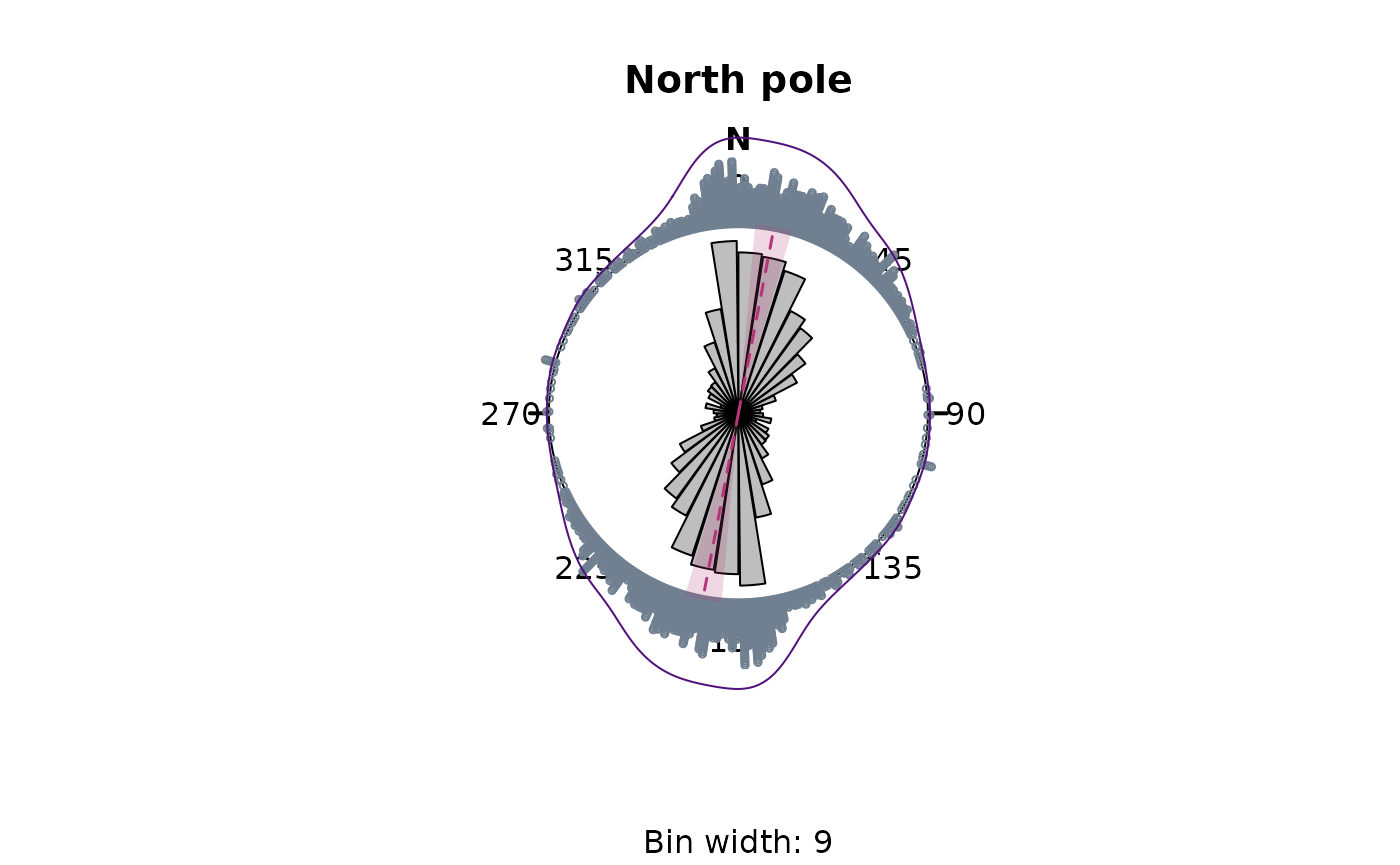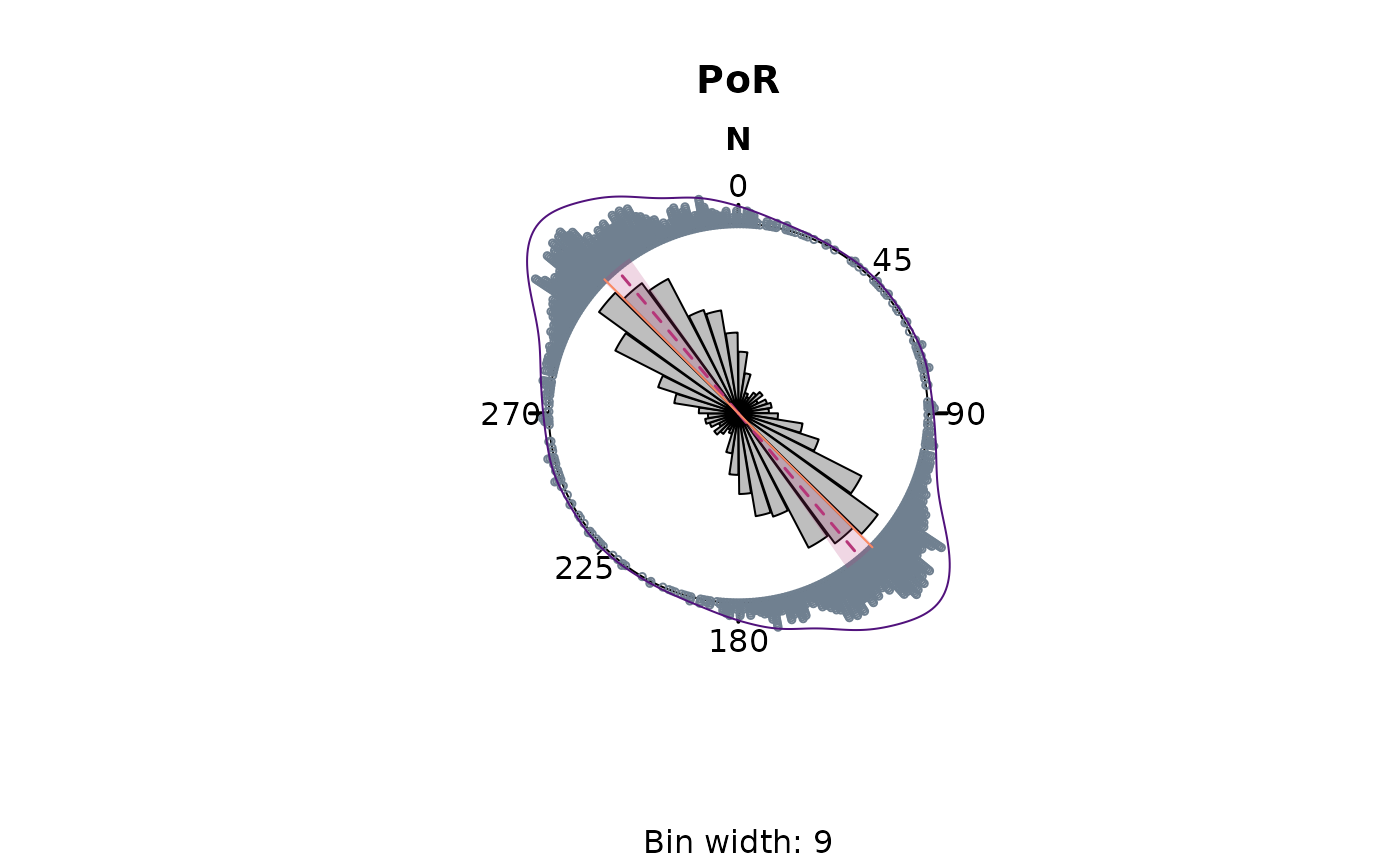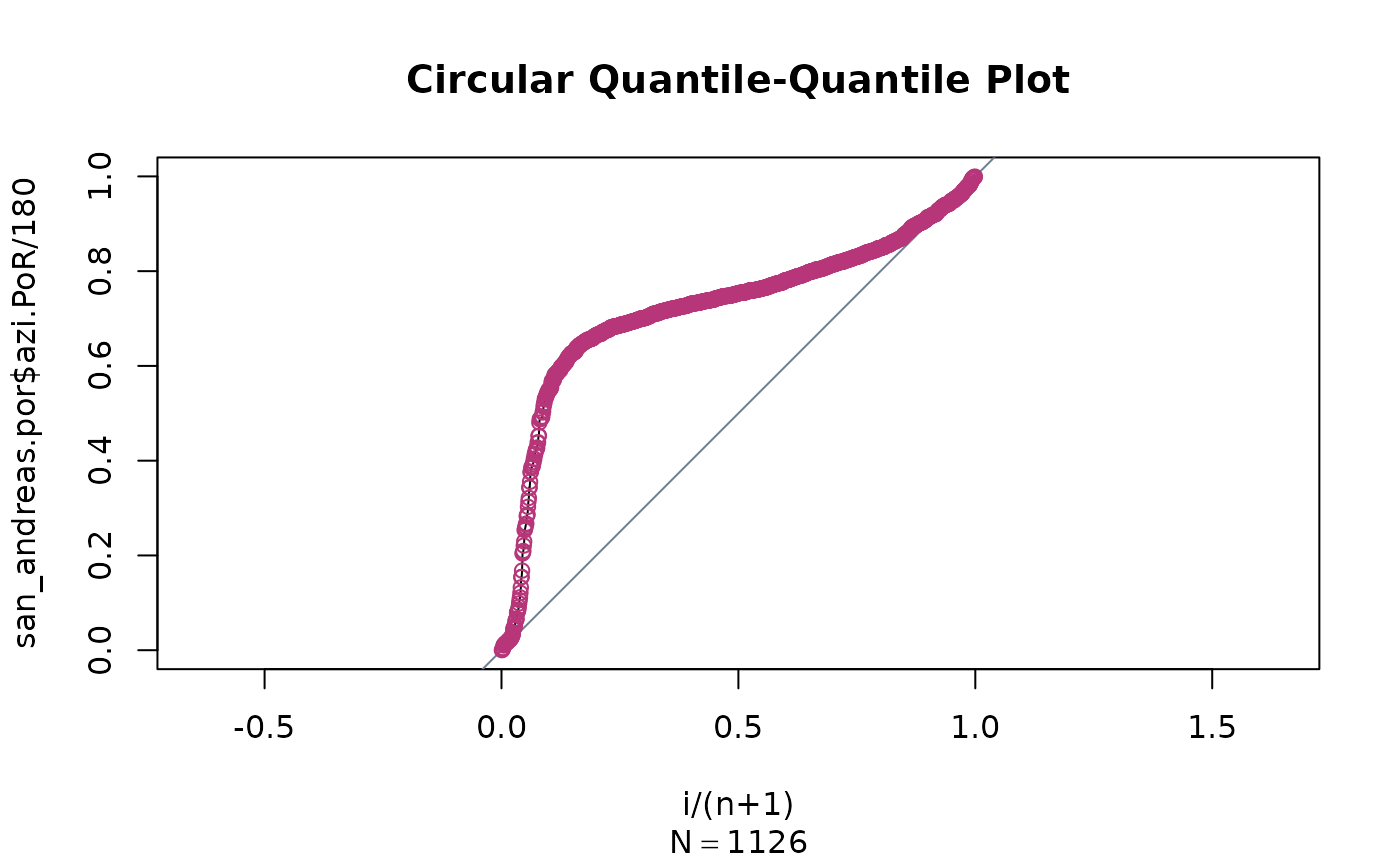This vignette teaches you how to retrieve statistical parameters of orientation data, for example the mean direction of stress datasets.
Orientation data types
Circular orientation data are two-dimensional orientation vectors that are either directional or axial.
- Directional data are -periodical, the angle is non-symmetrical on a circle. The modulus of the angle is (360°): α = α mod . Directional data usually involve processes where objects or particles were transported from one known place to another. Examples are wind direction, bird vanishing angles, plate motion, and fault slip directions.
- Axial data are -periodical, i.e. each direction is considered as equivalent to the opposite direction, so that the angles and are equivalent. The modulus of the angle is (180°): α = α mod . Data usually involves transport of objects where the origin is unknown or doesn’t matter as the transport could be extended infinitely. Examples are glacial striae, mineral alignments (long-axis of grain or crystal shapes), and principal stress/strain axes (e.g. shortening or compression direction, including the angle of the maximum horizontal stress ).
In (almost) every function in the tectonicr library, the
axialargument specifies whether your anglesxare axial (TRUE) or directional (FALSE). Because this package is mainly designed for analyzing stress orientations, the default isaxial=TRUE.
angles <- rvm(10, mean = 35, kappa = 20)
par(mfrow = c(1, 2), xpd = NA)
circular_plot(main = "Directional")
rose_line(angles, axial = FALSE, col = "#B63679FF")
circular_plot(main = "Axial")
rose_line(angles, axial = TRUE, col = "#B63679FF")
Mean direction
In case of axial data, the calculation of the mean of, say, of
35
and
355
should be 15 instead of
195.
tectonicr provides the circular mean
(circular_mean()) and the quasi-median
(circular_median()) as metrics to describe average
direction:
data("san_andreas")
circular_mean(san_andreas$azi)
#> [1] 10.64134
circular_median(san_andreas$azi)
#> [1] 35.5Again: if your angles are directional, you need to specify the
axialargument.
Note the different results:
circular_mean(san_andreas$azi, axial = FALSE)
#> [1] 53.66556
circular_median(san_andreas$azi, axial = FALSE)
#> [1] 36.5Quality weighted mean direction
Because the stress data is heteroscedastic, the data with less precise direction should have less impact on the final mean direction The weighted mean or quasi-median uses the reported measurements linear weighted by the inverse of the uncertainties:
w <- weighting(san_andreas$unc)
circular_mean(san_andreas$azi, w)
#> [1] 10.85382
circular_median(san_andreas$azi, w)
#> [1] 35.53572The spread of directional data can be expressed by the standard deviation (for the mean) or the quasi-interquartile range (for the median):
circular_sd(san_andreas$azi, w) # standard deviation
#> [1] 23.84385
circular_IQR(san_andreas$azi, w) # interquartile range
#> [1] 35Statistics in the Pole of Rotation (PoR) reference frame
NOTE: Because the orientations are subjected to angular distortions in the geographical coordinate system, it is recommended to express statistical parameters using the transformed orientations of the PoR reference frame.
data("cpm_models")
por <- cpm_models[["NNR-MORVEL56"]] |>
equivalent_rotation("na", "pa")
san_andreas.por <- PoR_shmax(san_andreas, por, type = "right")
circular_mean(san_andreas.por$azi.PoR, w)
#> [1] 139.7927
circular_sd(san_andreas.por$azi.PoR, w)
#> [1] 22.49684
circular_median(san_andreas.por$azi.PoR, w)
#> [1] 135.6247
circular_IQR(san_andreas.por$azi.PoR, w)
#> [1] 25.89473The collected summary statistics can be quickly obtained by
circular_summary():
circular_summary(san_andreas.por$azi.PoR, w, mode = TRUE)
#> n mean sd var 25% quasi-median
#> 1126.0000000 139.7927014 22.4968398 0.2653334 123.5288513 135.6247317
#> 75% median mode CI skewness kurtosis
#> 149.4235849 137.4843360 138.0821918 5.1165083 -0.2890426 1.6306589
#> R
#> 0.7346666The summary statistics additionally include the circular quasi-quantiles, the variance, the skewness, the kurtosis, the mode, the 95% confidence angle, and the mean resultant length (R).
Rose diagram
tectonicr provides a rose diagram, i.e. histogram for angular data.
rose(san_andreas$azi,
weights = w, main = "North pole",
dots = TRUE, stack = TRUE, dot_cex = 0.5, dot_pch = 21
)
# add the density curve
plot_density(san_andreas$azi, kappa = 20, col = "#51127CFF", scale = 1.1, shrink = 2, xpd = NA)
The diagram shows the uncertainty-weighted frequencies (equal area rose fans), the von Mises density distribution (blue curve), and the circular mean (red line) incl. its 95% confidence interval (transparent red).
Showing the distribution of the transformed data gives the better representation of the angle distribution as there is no angle distortion due to the arbitrarily chosen geographic coordinate system.
rose(san_andreas.por$azi,
weights = w, main = "PoR",
dots = TRUE, stack = TRUE, dot_cex = 0.5, dot_pch = 21
)
plot_density(san_andreas.por$azi, kappa = 20, col = "#51127CFF", scale = 1.1, shrink = 2, xpd = NA)
# show the predicted direction
rose_line(135, radius = 1.1, col = "#FB8861FF")
The green line shows the predicted direction.
QQ Plot
The (linearised) circular QQ-Plot (circular_qqplot())
can be used to visually assess whether our stress sample is drawn from
an uniform distribution or has a preferred orientation.
circular_qqplot(san_andreas.por$azi.PoR)
Our data clearly deviates from the diagonal line, indicating the data is not randomly distributed and has a strong preferred orientation around the 50% quantile.
Statistical tests
Test for random distribution
Uniformly distributed orientation can be described by the von Mises distribution1. If the directions are distributed randomly can be tested with the Rayleigh Test:
rayleigh_test(san_andreas.por$azi.PoR)
#> Reject Null Hypothesis
#> $R
#> [1] 0.7118209
#>
#> $statistic
#> [1] 570.5317
#>
#> $p.value
#> [1] 1.664245e-248Here, the test rejects the Null Hypothesis
(statistic > p.value). Thus the
directions have a preferred orientation.
Alternative statistical tests for circular uniformity are
kuiper_test() and watson_test(). Read
help() for more details…
Test for goodness-of-fit
Confidence intervals
Assuming a von Mises Distribution (circular normal distribution) of the orientation data, a confidence interval2 can be calculated:
confidence_interval(san_andreas.por$azi.PoR, conf.level = 0.95, w = w)
#> $mu
#> [1] 139.7927
#>
#> $conf.angle
#> [1] 5.116508
#>
#> $conf.interval
#> [1] 134.6762 144.9092The prediction for the orientation is . Since the prediction lies within the confidence interval, it can be concluded with 95% confidence that the orientations follow the predicted trend of .
Circular dispersion
The (weighted) circular dispersion of the orientation angles around the prediction is another way of assessing the significance of a normal distribution around a specified direction. The measure is based on the circular distance3 defined as where are the observed angles (here ), is the theoretical angles, and for directional data and for directional data. The (weighted) dispersion4 is
where s the number if observations, are weights of each observation, and is the sum of all weights .
It can be measured using circular_dispersion():
circular_dispersion(san_andreas.por$azi.PoR, y = 135, w = w)
#> [1] 0.1377952The dispersion parameter yields a number in the range between 0 and 1 which indicates the quality of the fit. Low dispersion values () indicate good agreement between predicted and observed directions (angle difference for axial data). High values () indicate a systematic misfit between predicted and observed directions of about (axial data). A misfit of and/or a random distribution of results in .
The standard error and the confidence interval of the calculated circular dispersion can be estimated by bootstrapping via:
circular_dispersion_boot(san_andreas.por$azi.PoR, y = 135, w = w, R = 1000)
#> $MLE
#> [1] 0.2643902
#>
#> $sde
#> [1] 0.01150477
#>
#> $CI
#> [1] 0.2422241 0.2861837Rayleigh Test
The statistical test for the goodness-of-fit is the (weighted) Rayleigh Test5 with a specified mean direction (here the predicted direction of ):
weighted_rayleigh(san_andreas.por$azi.PoR, mu = 135, w = w)
#> Reject Null Hypothesis
#> $C
#> [1] 0.7244095
#>
#> $statistic
#> [1] 34.37703
#>
#> $p.value
#> [1] 8.045524e-256Here, the Null Hypothesis is rejected, and thus, the alternative, i.e. an non-uniform distribution with the predicted direction as the mean cannot be excluded.
Orientation tensor
For axial orientation data, summary statistics can also be expressed by the 2D orientation tensor. The orientation tensor is related to the moment of inertia given, that is minimized by calculating the Cartesian coordinates of the orientation data, and calculating their covariance matrix:
$$ I = \left[ \begin{array}{@{}cc@{}} s_x^2 & s_{x,y} \\ s_{y,x} & s_y^2 \end{array} \right] = \left[ \begin{array}{@{}cc@{}} \frac{1}{n}\sum\limits_{i=1}^{n} (x_i-0)^2 & \frac{1}{n}\sum\limits_{i=1}^{n} (x_i-0)(y_i-0) \\ \frac{1}{n}\sum\limits_{i=1}^{n} (y_i-0)(x_i-0) & \frac{1}{n}\sum\limits_{i=1}^{n} (y_i-0)^2 \end{array} \right] = \frac{1}{n} \left[ \begin{array}{@{}cc@{}} \sum\limits_{i=1}^{n} x_i^2 & \sum\limits_{i=1}^{n} x_iy_i \\ \sum\limits_{i=1}^{n} x_iy_i & \sum\limits_{i=1}^{n} y_i^2 \end{array} \right] = \frac{1}{n} \sum\limits_{i=1}^{n} \left[ \begin{array}{@{}c@{}} x_i \\ y_i \end{array} \right] \left[ \begin{array}{@{}cc@{}} x_i & y_i \end{array} \right] $$
Orientation tensor and the inertia tensor are related by where denotes the unit matrix, so that .
The spectral decomposition of the 2D orientation tensor into two Eigenvectors and corresponding Eigenvalues provides provides a measure of location and a corresponding measure of dispersion, respectively.
The function ot_eigen2d()calculates the orientation
tensor and extracts the Eigenvalues and Eigenvectors. The function
accepts the weightings of the data:
ot_eigen2d(san_andreas.por$azi.PoR, w)
#> eigen() decomposition
#> $values
#> [1] 0.7259300 0.1054388
#>
#> $vectors
#> [1] -40.25985 49.74015The Eigenvalues () can be interpreted as the fractions of the variance explained by the orientation of the associated Eigenvectors. The two perpendicular Eigenvectors () are the “principal directions” with respect to the highest and the lowest concentration of orientation data.
The strength of the orientation is the largest Eigenvalue normalized by the sum of the eigenvalues. The smallest Eigenvalue is a measure of dispersion of 2D orientation data with respect to .
References
Bachmann, F., Hielscher, R., Jupp, P. E., Pantleon, W., Schaeben, H., & Wegert, E. (2010). Inferential statistics of electron backscatter diffraction data from within individual crystalline grains. Journal of Applied Crystallography, 43(6), 1338–1355. https://doi.org/10.1107/S002188981003027X
Mardia, K. V., and Jupp, P. E. (Eds.). (1999). “Directional Statistics” Hoboken, NJ, USA: John Wiley & Sons, Inc. https://doi.org/10.1002/9780470316979
Stephan, T., & Enkelmann, E. (2025). All Aligned on the Western Front of North America? Analyzing the Stress Field in the Northern Cordillera. Tectonics, 44(9). https://doi.org/10.1029/2025TC009014
Ziegler, Moritz O., and Oliver Heidbach. 2017. “Manual of the Matlab Script Stress2Grid” GFZ German Research Centre for Geosciences; World Stress Map Technical Report 17-02. doi: 10.5880/wsm.2017.002.
